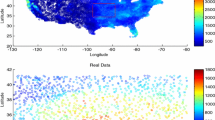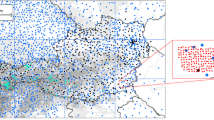Abstract
Kriging is a geostatistical estimation technique for regionalized variables that exhibit an autocorrelation structure. Such a structure can be described by a semivariogram of the observed data. The punctual-kriging estimate at any point is a weighted average of the data, where the weights are determined by using the semivariogram and an assumed drift, or lack of drift, in the data. The kriging algorithm, based on unbiased and minimum-variance estimates, involves a linear system of equations to calculate the weights. Kriging is applied in an attempt to describe the spatial variability of rainfall data over a geographical region in northern Greece. Monthly rainfall data of January and June 1987 have been taken from 20 measurement stations throughout the above area. The rainfall data are used to compute semivariograms for each month. The resulting semivariograms are anisotropic and fitted by linear and spherical models. Kriging estimates of rainfall and standard deviation were made at 90 locations covering the study area in a rectangular grid and the results used to plot contour maps of rainfall and contour maps of kriging standard deviation. Verification of the kriging estimates of rainfall are made by removing known data points and kriging an estimate at the same location. This verification is known as the jacknifing technique. Kriging errors, a by-product of the calculations, can then be used to give confidence intervals of the resulting estimates. The acceptable results of the verification procedure demonstrated that geostatistics can be used to describe the spatial variability of rainfall. Finally, it is shown how the property of kriging variance depends on the structure and the geometric configuration of the data points and the point to be estimated can also be used for the optimal design of the rain gauge network in an area.
Similar content being viewed by others
References
BastinG., LorentB., DuqueC., and GeversM.: 1984, Optimal estimation of the average areal rainfall and optimal selection of rain gauge locations, Water Resour. Res. 20(4), 463–470.
BurgessT. M. and WebsterR.: 1979, Optimal interpolation and isarithmic mapping of soil properties, I. The semi-variogram and punctual kriging, J. Soil. Sc. 31(2), 315–331.
BoxG. E. P. and JenkinsG. M.: 1976, Time Series Analysis: Forecasting and Control, Holden-Day, San Franciso.
ChangJ. T.: 1991, Investigation of precipitation droughts by use of kriging method. J. Irrig. Drainage Eng. 117, 935–943.
DelhommeJ. P.: 1978, Kriging in the hydrosciences, Adv. Water Resour. 1(5), 251–266.
GallichandJ., PrasherS. O., BroughtonR. S., and MarcotteD.: 1990, Kriging of hydraulic conductivity for subsurface drainage design, J. Irrig. Drainage Eng., 117(5), 667–681.
GambolatiG. and VolpiG.: 1979a, Groundwater contour mapping in Venice by stochastic interpolators: 1. Theory, Water Resour. Res. 15(2), 281–297.
GambolatiG. and VolpiG.: 1979b, A conceptual deterministic analysis of the kriging technique in Hydrology, Water Resour. Res. 15(3), 625–629.
HughesJ. P. and LettenmaierD. P.: 1981, Data requirements for kriging: estimation and network design, Water Resour. Res. 17(6), 1641–1650.
JournelA. G. and HuijbregtsC.: 1978, Mining Geostatistics, Academic Press, New York.
KrigeD. G.: 1951, A statistical approach to some basic mine valuation problems on the Witwatersrand, J. Chimic. Min. Soc. South-Africa 52: 119–139.
Martinez-CobA. and CuencaR. H.: 1991, Influence of elevation on regional evapotraspiration using multivariate geostatistics for various climatic regimes in Oregon, J. Hydrology 136, 353–380.
MatheronG.: 1971, The Theory of Regionalized Variables and Its Applications, Ecole de Mines, Fontainebleau, France.
NashM. H., DaughertyL. A., GutjahrA., WierengaP. P., and NanceS. A.: 1988, Horizontal and vertical kriging of soil properties along a transect in southern New Mexico, Soil Sci. Soc. Am. J. 52(4), 1086–1090.
OleaR. A.: 1975, Optimum Mapping Techniques Using Regionalized Variable Theory, Series on Spatial Analysis No. 2, Kansas Geological Survey, Lawrence.
PhilipR. D. and KitanidisP. K.: 1989, Geostatistical estimation of hydraulic head gradients, Ground Water 27(6), 855–865.
PucciA. A. and MurashigeJo A. E.: 1987, Applications of universal kriging to an aquifer study in New Jersey, Ground Water 25(6), 672–678.
TrangmarB. B., YastR. S., and UeharaG.: 1986, Spatial dependence and interpolation of soil properties in West Sumatra, Indonesia, I: Anisotropic variations, Soil Sci. Soc. Am. J. 50(6), 1391–1395.
Tzimopoulos, C. and Papadopoulou, E.: 1992, Application of the theory of regionalized variables for estimating sorptivity in an experimental field in Thessaloniki, Proc. Hellenic Hydrotechnical Association, Larisa, Greece, 9–12 November 1992, pp. 30–38.
VieiraS. R., NielsenD. R., and BiggarJ. W.: 1981, Spatial Variability of field-measured infiltration rate, Soil Sci. Soc. Am. J. 45, 1040–1048.
VieiraS. R., HatfieldJ. L., NielsenD. R., and BiggarJ. W.: 1982, Geostatistical theory and application to variability of some agronomical properties, Hilgardia 51(3), 1–75.
VilleneuveJ. R., MorinG., BobeeB., and LeblancD.: 1979, Kriging in the design of streamflow sampling networks, Water Resour. Res. 15(6), 1833–1846.
VolpiG., GampolatiG., CarbogninL., GattoP., and MozziG.: 1979, Groundwater contour mapping in Venice by stochastic interpolation, 2. Results, Water Resour. Res. 15(2), 291–297.
WebsterR. and BurgessT. M.: 1980, Optimal interpolation and isarithmic mapping of soil properties, III. Changing drift and universal kriging, J. Soil Sci. 31 (3) 505–524.
YatesS. R. and WarrickA. W.: 1987, Estimating soil water content using cokriging, Soil Sci. Soc. Am. J. 51(1), 23–30.
Author information
Authors and Affiliations
Rights and permissions
About this article
Cite this article
Papamichail, D.M., Metaxa, I.G. Geostatistical analysis of spatial variability of rainfall and optimal design of a rain gauge network. Water Resour Manage 10, 107–127 (1996). https://doi.org/10.1007/BF00429682
Received:
Accepted:
Issue Date:
DOI: https://doi.org/10.1007/BF00429682




